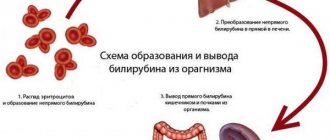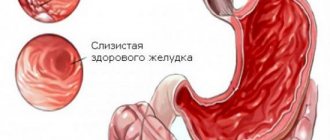Hepatitis C - symptoms and treatment
Viral hepatitis C is an acute or chronic infectious disease caused by various types of hepatitis C virus, which mainly affect hepatocytes (liver cells) and cause the development of an inflammatory process in the liver. When a number of factors, lifestyle and lack of adequate treatment are combined, hepatitis C viruses lead to cirrhotic tissue restructuring and liver cancer (hepatocellular carcinoma).
A summary of the article is in the video:
The etiological agent is hepatitis C virus (HCV). The virus was first isolated by American scientists in 1989.
Taxonomic structure:
- kingdom - viruses
- family - Flaviviridae
- genus - Hepacivirus
- species - hepatitis C virus (HCV) - 7 genotypes and 67 subtypes
Etiological and morphological properties of the virus
The diameter of the virion (viral particle) is 50 nanometers. It has an outer protein-lipid shell. The shell of the viral particle is formed, among other things, due to the interaction of the virus with the host’s low-density lipoproteins, which allows it to escape from immune attack and penetrate cells.
The genetic structure is a linear, single-stranded ribonucleic acid (RNA) molecule, approximately 9400 nucleotides in size. The following zones are distinguished in it: encrypting structural (E1 and E2 proteins) and non-structural (functional) proteins - NS2, NS3, NS4A, NS4B, NS5A, NS5B, which are responsible for various functions in the life of the virus. Structural proteins determine the direct cytopathic effect (cell damage), polymorphism (diversity) of the virus, and participate in the effect of penetration and exit from the cell. Non-structural proteins are involved in the development and reproduction of the virus and determine the development of resistance to interferons (NS5A). No integration of viral RNA into the genome of human cells has been observed.
The virus is heterogeneous (there are various subspecies - genotypes). This is due to the fact that the speed of its replication is enormous (1011-1012 per day) and as a result, a large number of errors occur - the virus quickly mutates. Such mutations allow the virus to evade the human immune response and remain in the body for a long time, as well as resist the effects of drugs. The main reservoir of the virus is liver cells, but it can also multiply in cells of the immune system (macrophages, monocytes, etc.).
In general, the virus is not stable in the environment. Under the influence of chloroform, alcohol, chlorhexidine and other disinfectants, it dies almost instantly, inactivates at a temperature of 100 ° C in 2 minutes, at a temperature of 60 ° C in 30 minutes. At room temperature it lives no more than four days; under the influence of ultraviolet radiation it dies in 30 minutes. In plasma, erythrocyte mass, etc., it can persist for up to a year. It is not cultivated in cell cultures, does not have hemagglutinating (gluing red blood cells) and hemolytic (destroying red blood cells) activity [2][8][10][11].
Hepatitis C virus transmission
The virus is transmitted only through blood. The infectious dose is several tens of times greater than for hepatitis B, i.e., visible traces of blood are needed for infection. But the routes of infection are different:
- drug use;
- medical manipulations (including piercing, tattoo, etc.);
- sexual intercourse (unprotected sexual intercourse, on average about 1.5% in a heterosexual family);
- from mother to child during childbirth;
- household way (use of common razors, scissors, toothbrushes).
Hepatitis C is not transmitted by kissing, shaking hands, through dishes, dry blood stains on clothing, through water, by coughing, sneezing, sweating, sitting next to each other, through the air, etc. It is also impossible to become infected through breast milk, but infection is possible when the mother’s blood comes into contact with the baby’s damaged lips. There is a minor risk if infected blood gets into the eyes, but these are isolated cases. It is almost impossible to become infected through a blood transfusion, since blood for hepatitis C is tested using the PCR (polymerase chain reaction) method with high sensitivity.
There are no scientific reasons to limit the choice of profession, work and social circle of people with hepatitis C - transmission occurs only through blood, so there should be no restrictions on work (for example, as a teacher, doctor, nanny), contacts with relatives, etc.
Territorial distribution
Hepatitis C is common throughout the world. It is most common in the WHO Eastern Mediterranean Region and the WHO European Region, where HCV prevalence was estimated to be 2.3% and 1.5%, respectively, in 2015. The total number of patients with viral hepatitis C in the world is at least 150 million, in the Russian Federation it is unknown (according to some sources, the estimated number of patients is at least 2 million people). As of 2016, at least 2.4 million people were infected in the United States (according to other sources, at least 4 million). According to the most conservative estimates, at least 15 thousand people died from hepatitis C in this country in 2018. In the Russian Federation, genotypes 1b and 3a are prevalent, but the frequency of their detection can vary significantly depending on the region [4][7][9].
Currently, viral hepatitis C is spreading in the general population, i.e. people of all ages and social classes are susceptible to the disease, but the following categories are at greatest risk:
- injection drug users;
- HIV-infected;
- patients of hemodialysis departments;
- persons who have undergone organ transplantation (currently less important);
- health workers;
- children born to mothers with hepatitis C;
- marginalized sections of society, sex workers.
After suffering from acute viral hepatitis C, approximately 30% of people heal themselves, i.e. they completely get rid of the virus; in other cases, chronic hepatitis develops. Predictors (prognostic parameters) of self-healing are jaundice, high ALT levels, young age, female gender, 1 genotype of the virus, the presence of hepatitis B with HbsAg (hepatitis B virus antigen). Every 5-25 people out of 100 develop cirrhosis of the liver within 10-20 years from the moment of infection during chronicity and they have a 1-4% annual chance of developing liver cancer.
Provoking factors for the development of liver cirrhosis:
- male gender;
- age over 50 years;
- alcohol abuse;
- co-infection with HIV, hepatitis B or steatohepatitis;
- immunosuppressive therapy.
You can become infected with hepatitis C after recovery from a previous case (even with the same genotype), or you can become infected with a different genotype, even if a person already has hepatitis C of any genotype (superinfection). In this case, there is a struggle between genotypes for dominance. As a rule, one wins, and the other can persist at minimal levels of replication. In this case, there is a risk of error in determining the genotype.
The immunogenicity of the virus is weak, i.e. antibodies that should be produced in response to infection appear slowly (no earlier than 3 weeks after infection) and do not have a clear virus-neutralizing effect [2][4][8][9].
Methods of infection
The pathogen is transmitted through the blood and sometimes enters the body through other biological fluids:
- saliva;
- urine;
- sperm.
Direct entry of the virus into the blood of a healthy patient becomes a prerequisite for infection. The disease is registered in drug addicts who prefer intravenous administration of prohibited substances and use shared syringes. The infection occurs in almost 80% of people suffering from drug addiction.
An increased risk of infection occurs:
- with frequent blood transfusions;
- surgical interventions;
- punctures and injections.
The main condition for the penetration of the virus is the use of non-sterile instruments intended for repeated use. A similar problem occurs:
- in pedicure and manicure salons;
- dental clinics;
- tattoo parlors.
In half of the cases it is impossible to accurately determine the route of infection. Sexual contacts, as a source of hepatitis C, are practically not recorded. The problem occurs in HIV-infected people with promiscuous sexual intercourse.
Childhood infection is caused by a sick mother and transmission of the pathogen during intrauterine development. In the second case, the disease occurs in babies with congenital immunodeficiency and through direct contact with the virus.
3.Diagnosis of the disease
Many people find out that they have hepatitis C by accident. For example, during annual preventive examinations or when donating blood. Often people with hepatitis C have high levels of liver enzymes in their blood. The most accurate method for diagnosing hepatitis C is a special blood test for hepatitis C.
. It can show whether you have ever had hepatitis C and whether you currently have it.
If a blood test shows hepatitis C, a further test may be needed - a liver biopsy - to see if the virus has caused scarring in the liver. During a liver biopsy
A small sample of tissue is taken using a special needle, which is then examined under a microscope.
There are also special home tests to determine hepatitis C.
. They can be bought at the pharmacy. In any case, if such a test shows the presence of the virus now or in the past, it is necessary to consult a good hepatologist.
About our clinic Chistye Prudy metro station Medintercom page!
Who should be tested for the virus?
Some categories of citizens have an increased risk of contracting HCV infection. These include:
- drug addicts, including non-injecting drug users;
- gay and bisexual men, people of any gender with risky sexual behavior who neglect protection measures;
- patients with HIV infection;
- people who undergo invasive procedures, including blood transfusions, in health care settings with inadequate infection control;
- citizens in places of deprivation of liberty, various closed institutions;
- lovers of tattoos and piercings;
- children whose mothers have a confirmed diagnosis of hepatitis C.
Clinical picture
The duration of the incubation period of the disease is from 2 weeks to 6 months, depending on the method of transmission. During the acute phase, most patients have no pronounced symptoms and no characteristic yellowish tint of the skin. The disease is determined at the end of the specified period by laboratory tests, when primary signs of pathology appear.
General symptoms of hepatitis C are:
- in general weakness;
- apathetic state;
- decreased appetite and rapid satiety;
- discomfort in the area of the right hypochondrium;
- dyspeptic disorders.
Fever and signs of intoxication occur in exceptional cases. The temperature does not rise above subfebrile levels. The severity of symptoms depends on the amount of virus accumulated in the blood and the functioning of the immune system.
In the acute course of the disease, a slight yellowing of the dermis occurs, sometimes the changes affect only the whites of the eyes. During the transition to the chronic phase, jaundice and increased liver enzymes are recorded only during exacerbation.
A severe form of the disease occurs in 1% of patients, it provokes:
- decreased leukocyte levels;
- inhibition of the hematopoietic function of the bone marrow;
- damage to peripheral nerves - neuritis.
This type of hepatitis C causes death. In the standard course of the pathology, symptoms and disorders occur with serious liver damage; several years may pass from the moment of infection to the first clinical signs.
Alternative medicine and self-medication with dubious drugs lead to a rapid transition from the acute phase to the chronic phase and the development of serious complications. The lack of timely therapy causes death due to liver destruction and dysfunction.
Deadly tattoos
The source of infection is the blood of an infected person. Until 1989, the main routes of infection were blood transfusions and surgical interventions. With the introduction of preventive measures, namely testing donated blood for virus “C” and using only disposable syringes and instruments, the main route of infection became the use of unsterile needles when injecting drugs, tattoos, and piercings. Infection is also possible through sexual contact, especially if there are multiple sexual partners. Transmission of the virus from an infected mother to a child occurs during childbirth in 5% of cases. The problem is complicated by the fact that vaccinations against hepatitis C have not yet been developed.
Cirrhosis of the liver
Liver cirrhosis is a chronic liver disease. With it, liver tissue is replaced by connective tissue, which ultimately leads to cessation of liver function.
Viruses that cause hepatitis cause inflammation in liver cells, which leads to their destruction. If the inflammation is very severe, cell destruction progresses and a layer of scar tissue forms. In advanced cases, the liver decreases in size.
Due to the disrupted structure, changes occur in the portal blood flow and increased pressure in v. Portae, which leads to dilation of the veins of the esophagus and stomach (varicose veins). If these blood vessels rupture, bleeding may occur. Ascites, an accumulation of fluid in the abdominal cavity, also develops due to increased portal pressure. This is partly due to a lack of protein, as the function of the liver, which synthesizes albumin, is reduced as a result. Other signs and symptoms include coagulation disorders, jaundice, itching, dark urine, spider nevi (usually on the skin, patchy red spots with spider-like blood vessels spreading out), etc.
About 3-5% of people infected with hepatitis B virus develop the chronic form, and only half of these will develop cirrhosis.
Cirrhosis is an incurable disease. But the right diet and treatment can slow its progress. In patients with hepatitis B, the five-year survival rate after established cirrhosis is 71%.
General retreat of the disease
Just a few years ago, chronic hepatitis C was considered an incurable disease. But medicine does not stand still. Currently, it is possible not only to reduce the activity or slow down the development of the disease, but also to completely cure it. The basis of modern treatment for hepatitis C is interferon-alpha preparations. Interferons are proteins produced in the body of every person that have antiviral activity. The activity of interferons produced by the human body is sometimes not enough to fight the insidious and changeable “chameleon” - the hepatitis C virus. The administration of interferon drugs helps the body cope with the infection. The combination of interferon with other antiviral drugs (in particular, ribavirin) significantly increased the effectiveness of therapy. Treatment is carried out on average for a year under the supervision of a specialist doctor. The key to success is the earliest possible diagnosis and initiation of treatment, although it is possible even at the stage of liver cirrhosis.
Hepatitis B virus
The content of the article
The hepatitis B virus belongs to a group of DNA viruses - the Hepadnaviridae family. It consists of double-stranded DNA and is replicated using the enzyme reverse transcriptase. It has three main antigens: HbsAg (surface antigen), HbcAg (core antigen) and HbeAg (endogenous - internal antigen). It is divided into 8 genotypes.
It was opened in 1963. Bloomberg and his staff called it the "Australian antigen" because it was found in the blood of Aboriginal people in Australia. This virus is a hundred times more contagious than HIV, the virus that causes AIDS.











